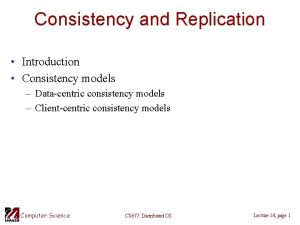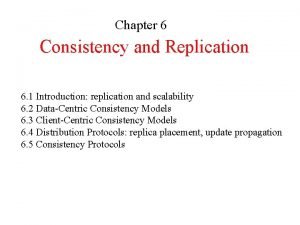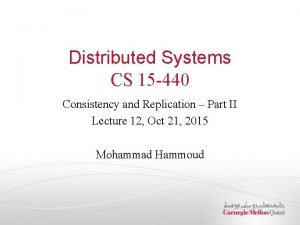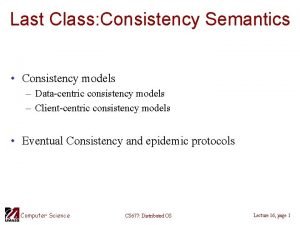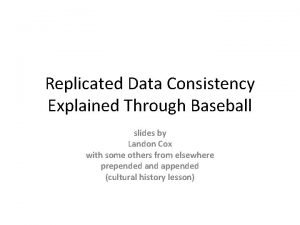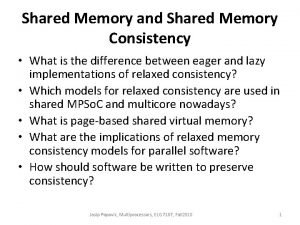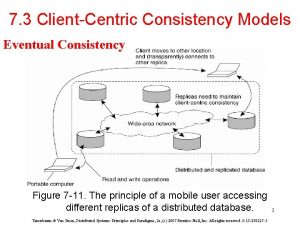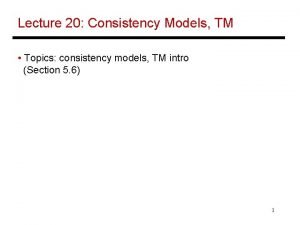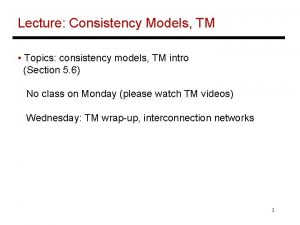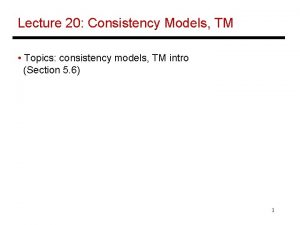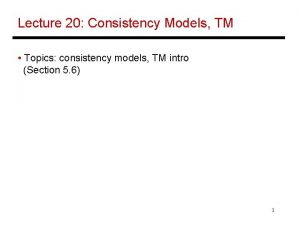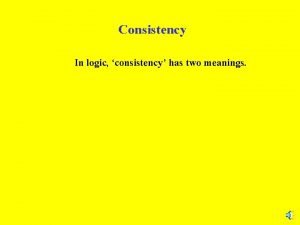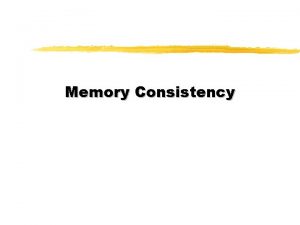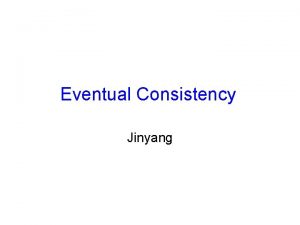Client Centric Consistency ClientCentric Consistency Models n n





















- Slides: 21

Client Centric Consistency

Client-Centric Consistency Models n n Data-centric consistency models aim at providing the system-wide view on a data store. Client-centric consistency models are generally used for applications that lack simultaneous updates n n Most operations involve reading data. Weak, client-centric consistency models n n n Eventual consistency Monotonic reads Monotonic writes Read your writes Writes follow reads

Client-Centric Consistency Models Goal: Show we can perhaps avoid system-wide consistency, by concentrating on what specific clients want, instead of what should be maintained by servers. Background: Most large-scale distributed systems apply replication for scalability, but can support only weak consistency. DNS: Updates are propagated slowly, and inserts may not be immediately visible. News: Articles and reactions are pushed and pulled throughout the Internet, such that reactions can be seen before postings. Lotus Notes: Geographically dispersed servers replicate documents, but make no attempt to keep (concurrent) updates mutually consistent. WWW: Caches all over the place, but there need be no guarantee that you are reading the most recent version of a page.

Eventual Consistency n n n Systems such as DNS and WWW can be viewed as applications of large scale distributed and replicated databases that tolerate a relatively high degree of inconsistency Common Assumption – if no updates take place for a long time, all replicas will gradually and eventually become consistent This form of consistency is called eventual consistency Eventual consistency requires only that updates are guaranteed to propagate to all replicas Eventual consistent data stores work fine as long as clients always access the same replica – what happens when different replicas are accessed?

Basic Architecture

Consistency for Mobile Users – Inconsistencies n Various inconsistencies may occur as a mobile user moves from location A to location B n n Updates at A may not have yet been propagated to B May be reading newer entries than the ones available at A Updates at B may eventually conflict with those at A The consistency model must ensure that the entries updated and/or read at by the mobile user at A, are in B the way you left them in A. n This requirement ensures that the database will appear to be consistent to you.

Client-centric Consistency n n n For the mobile user example, eventual consistent data stores will not work properly Client-centric consistency provides guarantees for a single client concerning the consistency of access to a data store by that client No guarantees are given concerning concurrent accesses by different clients

Client-Centric Consistency – Guarantees n n Guarantees are the responsibility of “session manager”, not servers Two sets are maintained n n Read-set – set of writes that are relevant to session reads Write-set – set of writes performed in session Update dependencies captured in read sets and write sets Four different client-central consistency models n n Monotonic reads Monotonic writes Read your writes Writes follow reads

Monotonic-Read Consistency n A data store is said to be monotonic-read consistent if the following condition holds: n n n If a process reads the value of a data item x, any successive read operation on x by that process will always return that same or a more recent value. Consequently, if a process has seen a value of x at time t, it will never see an older version of x at a later time Notation: WS(xi[t]) is the set of write operations (at Li) that lead to version xi of x (at time t) n WS(xi[t 1]; xj [t 2]) indicates that it is known that WS(xi[t 1]) is part of WS(xj[t 2])

Monotonic Reads – Consistency n A data store that is monotonic-read consistent n n n P performs a read operation on x at L 1, R(x 1). Later, P performs a read operation on x at L 2, R(x 2) Effects of write operations can be seen by succeeding read operations n Expressed by WS(x 1; x 2) which states WS(x 1) is part of WS(x 2)

Monotonic Reads – No Consistency n The read operations performed by a single process P at two different local copies of the same data store. (b) A data store that does not provide monotonic reads.

Monotonic Writes In a monotonic-write consistent store, the following condition holds: n A write operation by a process on a data item x is completed before any successive write operation on x by the same process.

Monotonic Writes n A monotonic-write consistent data store. n n Two write operations performed by a single process P at two different locations WS(x 1) indicates that previous write operation at L 1 has been propagated to L 2

Monotonic Writes (3) n A data store that does not provide monotonicwrite consistency n Write operation at L 1 has not propagated to L 2

Read Your Writes n A data store is said to provide read-your-writes consistency, if the following condition holds: The effect of a write operation by a process on data item x will always be seen by a successive read operation on x by the same process.

Read Your Writes n A data store that provides read-your-writes consistency n n WS(x 1) is the series of write operations that took place since initialization at a local copy. WS(x 1; x 2) denotes that operations in WS(x 1) also been performed at another local copy that has its set of operations in WS(x 2).

Read Your Writes n A data store that does not provide read-your-writes consistency

Writes Follow Reads n A data store is said to provide writes-follow-reads consistency, if the following holds: A write operation by a process on a data item x following a previous read operation on x by the same process is guaranteed to take place on the same or a more recent value of x that was read.

Writes Follow Reads (2) n A writes-follow-reads consistent data store.

Writes Follow Reads n A data store that does not provide writes-followreads consistency.

Consistency Models n n Background – Replication Motivation Data-Centric Consistency Models n n n Continuous Consistency Consistent Ordering of Operations Client-Centric Consistency Models n n n Eventual Consistency Monotonic Reads Monotonic Writes Read Your Writes Follow Reads
 Monotonic write consistency
Monotonic write consistency Distributed data store
Distributed data store Network centric computing and network centric content
Network centric computing and network centric content Data centric consistency model
Data centric consistency model Explain data centric consistency model
Explain data centric consistency model Continuous consistency in distributed system
Continuous consistency in distributed system Explain data centric consistency model
Explain data centric consistency model Acid vs base
Acid vs base Distributed shared memory architecture tutorialspoint
Distributed shared memory architecture tutorialspoint Memory consistency
Memory consistency Vmatrix server manager
Vmatrix server manager Client lourd vs client léger
Client lourd vs client léger Application layer
Application layer What is the difference between models & semi modals?
What is the difference between models & semi modals? Unilateral occlusal balance
Unilateral occlusal balance Designing learner-centric moocs
Designing learner-centric moocs Document centric website
Document centric website Unusual tourist adalah
Unusual tourist adalah Ethnocentric orientation
Ethnocentric orientation Vertical jaw relations
Vertical jaw relations Network centric solutions
Network centric solutions Anti monson curve
Anti monson curve



